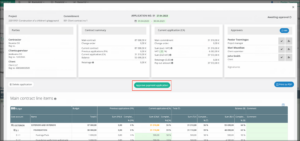In the construction industry, selecting the proper billing method is crucial as it directly impacts cash flow, project management, and client relationships. Different types of construction billing approaches suit various projects, each offering distinct benefits and posing specific challenges.
Here are seven of the most common construction billing methods in the construction industry:
Table of Contents
1. Lump Sum Billing
Lump-sum billing, or fixed-price billing, is a method where the contractor and the client agree on a total price for a project before any work starts. In this arrangement, the contractor charges the client a predetermined amount, typically invoiced at regular intervals like monthly or at specific project milestones. Unlike other billing methods, lump-sum does not usually require the contractor to present detailed cost breakdowns or profit margins, simplifying the paperwork and administration involved.
Benefits of Lump-Sum Billing
One significant advantage for contractors using lump-sum billing is the potential for increased profits. For example, if a contractor agrees to a $100,000 deal with a client but manages to complete the project with only $80,000 in expenses, the $20,000 surplus becomes direct profit. This billing method also allows contractors some flexibility in managing their finances across different project segments, reallocating profits from more successful aspects to cover any shortfalls elsewhere without the need for detailed financial disclosures to the client. The reduced need for extensive documentation can also save administrative costs and time.
Drawbacks of Lump-Sum Billing
However, lump-sum billing carries inherent risks, primarily when unexpected costs arise. Contractors might face financial losses if the project exceeds the budget unless they can negotiate change orders to cover these unforeseen expenses. Such negotiations often require detailed contract language outlining possible scenarios that might impact costs, adding complexity to the agreement. If something is overlooked in the project’s scope, it could negatively impact the contractor’s profit margins.
Appropriate Situations for Lump-Sum Billing
Lump-sum billing is often preferred for smaller projects or projects with clearly defined scopes to minimize uncertainties. It is favored by contractors who value simplicity and predictability in financial management and clients less experienced with construction projects. They may benefit from the straightforward nature of a single, fixed cost. However, this method can pose significant financial risks for very large or complex projects due to the potential for cost overruns and the competitive pressure in the bidding process.
In summary, while lump-sum billing can streamline a project’s financial aspects and potentially increase contractors’ profitability, it also requires careful consideration of the project’s scope and potential risks to ensure it is the most suitable billing approach.
2. Cost Plus Billing
Cost-plus billing, or cost-reimbursable billing, is a payment structure where a contractor bills a client for all actual project costs plus an additional fee to cover overhead and profit. This fee could be a fixed amount or a percentage of the project costs. This method is typically chosen for projects where the scope and costs are not clearly defined upfront, providing transparency for the client by detailing every expense.
Benefits of Cost-Plus Billing
The primary advantage of cost-plus billing is its transparency, allowing clients to see exactly where their money is going. Contractors benefit by passing most of the financial risk to the client, ensuring they are compensated for all costs incurred plus their profit margin, even if the project exceeds initial cost estimates. This model is particularly suitable for complex projects with variable scopes, where predicting exact costs is challenging. It also allows for flexible adjustments during the project, such as when material and labor costs increase unexpectedly. Some contracts may include a “Guaranteed Maximum Price” clause to cap spending, which helps control the budget from the client’s perspective.
Drawbacks of Cost-Plus Billing
However, the cost-plus model requires extensive documentation, which can be burdensome for both parties. Contractors must keep detailed records of expenses, including labor hours, materials, equipment rentals, and other direct and indirect costs. Clients must review and approve these documents before funds are released, which can be time-consuming and lead to large volumes of paperwork. Furthermore, since every cost needs to be justified, disputes over what qualifies for reimbursement can arise, complicating the relationship between contractor and client. The necessity for contractors to front the costs can also affect their cash flow, particularly if payments are delayed.
When to Use Cost-Plus Billing
Cost-plus billing is best used for large-scale or complex projects where the final scope isn’t clearly defined initially. It suits owners who prefer understanding all the costs involved in their projects and are comfortable with some financial uncertainty in exchange for transparency. It’s also advisable in scenarios where project specifications are expected to evolve, requiring a degree of adaptability in budgeting and execution.
While cost-plus contracts offer flexibility and transparency, they come with a higher administrative burden and potential financial disputes. They require clear contract language and thorough documentation to protect both parties and ensure the project can proceed smoothly.
3. Time and Materials Billing
Time and Materials (T&M) billing is a payment model in which clients are invoiced based on the labor hours worked and the cost of materials used in a project. This approach includes a profit margin built into the hourly rates and materials costs provided to the client. It’s particularly effective for projects where the scope isn’t clearly defined from the outset or is expected to evolve.
Advantages of Time and Materials Billing
Time and Materials billing provides significant flexibility, particularly suitable for projects with uncertain or changing requirements. Since the contractor charges for actual work done and materials used, there is less risk of underestimating the total cost, which can often happen in fixed-price contracts. This method allows contractors to adjust the workload and resources as the project progresses, offering an advantage when material prices fluctuate or unexpected challenges arise. For subcontractors, this model minimizes the stress of unforeseen delays impacting their profitability.
Disadvantages of Time and Materials Billing
However, the main drawback of T&M construction billing process is its unpredictability regarding the final project cost, which can be higher than initially estimated if the project extends beyond the expected time frame or if additional materials are needed. This can cause client dissatisfaction due to the lack of a capped budget, making it difficult to plan financially. Additionally, this method requires meticulous tracking and documentation of hours worked and materials purchased to ensure accurate billing and transparency.
When to Use Time and Materials Billing
T&M billing is most effective for smaller projects or specific aspects of more extensive projects (such as self-performed work by general contractors) requiring high adaptability. It’s also useful in scenarios where the project scope is not fully defined, allowing both parties to adjust the scope and resources as the work progresses. Implementing not-to-exceed limits can help control costs, providing clients with some level of budget security while maintaining the flexibility of the T&M approach.
In summary, Time and Materials billing is an excellent choice for projects that are too complex or undefined to estimate accurately at the outset. It aligns the cost with the actual work done, ensuring fairness for both contractors and clients, albeit with a need for careful management and transparent documentation.
4. Unit Price Billing
Unit price billing is a billing strategy in the construction business where contractors charge for each specific unit of work done, such as per cubic yard of concrete laid or per truckload of material delivered. This method allows costs to be broken down into smaller, more manageable segments, allowing contractors to charge for exactly what is used or done.
Advantages of Unit Price Billing
One of the primary advantages of unit price billing is its clarity and transparency. Clients can see exactly what they are paying for, which helps manage budgets more effectively. It simplifies the invoicing process as each unit of work is predefined and priced, making it straightforward for the contractor and the client to understand the costs involved. This is particularly useful in projects where material quantities and scope are difficult to estimate in advance. Contractors can adjust billing based on the actual units consumed, which can be advantageous in managing long-term projects or those with variable requirements.
Disadvantages of Unit Price Billing
However, there are challenges associated with unit price billing. Since the total project cost depends on the number of units used, there can be budget uncertainty until the project is complete. This makes it difficult for owners to predict the final project cost, potentially leading to budget overruns if more units are needed than initially expected. Furthermore, accurate and consistent record-keeping is essential to avoid any billing disputes or over billing, which adds an administrative burden. Contractors need to meticulously track the units of work completed to ensure accurate billing and avoid discrepancies that could delay payments.
When to Use Unit Pricing
Unit price billing is most effective for large-scale projects with repetitive tasks or where work components are standardized, such as road construction or utility installations. It’s also advantageous when the scope of work might expand or change, as it allows flexibility to adjust the billing based on actual work done without renegotiating the entire contract. This billing method can be combined with others, such as time and materials or fixed-price contracts, to tailor the billing to specific project needs or to provide more predictability for the client.
In summary, while unit pricing offers clarity and flexibility, it requires careful management and detailed documentation. It is suitable for projects with uncertain scopes or where detailed tracking of materials and labor per unit is feasible.
5. AIA style progress billing
Progress billing, commonly associated with the American Institute of Architects (AIA) standardized forms, is a widely used billing method in construction where contractors submit invoices based on the percentage of work completed at different project stages. This method helps ensure a steady cash flow throughout the project, which can be crucial for maintaining operations and managing expenses efficiently.
How AIA-Style Progress Billing Works
In AIA-style progress billing, contractors prepare and issue invoices according to a predetermined schedule of values that breaks down the project into measurable segments. When a milestone is reached, the contractor invoices for that portion of the work, typically based on a percentage of the total project cost. For instance, if 30% of the project is completed, the contractor issues an invoice for 30% of the agreed total contract value.
The billing process often involves two essential AIA forms: the G-702 Application and Certificate for Payment and the G-703 Continuation Sheet. The former tracks the overall financial details of the project, including the original contract amount, previous payments, change orders, and the amount currently due. The latter supports the payment application by providing detailed backup information on the completed portions of the work.
Advantages of AIA-Style Progress Billing
The primary benefits of this method include its standardized approach, which brings clarity and professionalism to the financial management of a construction project. It allows for consistent cash flow, reducing the financial strain of waiting until project completion for payment. Additionally, integrating this billing method with modern construction management software can significantly streamline the process, making it quicker and reducing the likelihood of errors.
Disadvantages of AIA-Style Progress Billing
However, the method is not without its challenges. Disputes can arise over the percentage of work completed, requiring detailed and accurate documentation to support every invoice issued. The complexity and meticulous nature of AIA billing mean that errors can have significant implications, potentially leading to disputes or compliance issues. Furthermore, the cost of using official AIA forms and potentially customizing them can add to project expenses, impacting overall profitability.
When to Use AIA-Style Progress Billing
This billing approach is best suited for more extensive, long-term projects where the scope involves multiple stages and complex deliverables. It’s particularly useful when precise, regular financial oversight is necessary and the project demands a structured approach to revenue recognition. AIA-style billing is ideal when maintaining regular cash flow as crucial as accurately reporting project progress.
In summary, AIA-style progress billing offers a systematic and professional way to manage construction project finances, ensuring that payments are aligned with completed work. While it demands thorough documentation and can increase administrative tasks, the benefits of maintaining consistent cash flow and having a clear financial picture at all project stages often outweigh these challenges.
6. Retainage Billing
Retainage billing is a common financial practice in the construction industry. In this method, the client withholds a certain percentage of the payment until the project is completed or specific milestones are met. This method serves as a financial safety net for construction company, ensuring that the contractor meets all the project specifications and quality standards before receiving the full payment.
How Retainage Billing Works
Under retainage billing, the client and contractor agree upon a fixed percentage of the total contract amount to be withheld during the project. As the contractor completes various stages or milestones, they invoice the client for the value of the work minus the agreed-upon retainage amount. This withheld amount, often 5% to 10% of the total contract value, is then released to the contractor once the project is fully completed to the client’s satisfaction or when certain contractual conditions have been satisfied.
Benefits and Considerations
The primary benefit of retainage billing is that it provides an incentive for contractors to complete the project according to the predetermined quality and timeliness criteria. It also gives the client some leverage and security against subpar performance or non-compliance with the project terms.
However, one challenge of retainage billing is that it can impact the contractor’s cash flow, as a portion of their earnings is deferred until the project’s conclusion. This can be particularly significant on long-term projects where the retained amount might accumulate substantially.
In summary, retainage billing is widely used in construction and other project-based industries to ensure quality and fulfillment of contractual obligations. It helps manage risks for the client while encouraging contractors to adhere strictly to project specifications.
7. Guaranteed Maximum Price (GMP) billing
Guaranteed Maximum Price (GMP) billing is a method in which the contractor agrees to a fixed cost for completing a project but with an established ceiling on the total price. This cap ensures that any cost savings below the agreed maximum benefit the client rather than the contractor. This is a departure from the traditional lump sum billing, in which the contractor would retain these savings. GMP is a compromise between lump sum and time and materials billing, providing some predictability while offering cost control.
Advantages of Guaranteed Maximum Price
One key benefit of GMP contracts is the transfer of financial risk from the owner to the contractor. This arrangement favors the owner, as it caps their financial liability and incentivizes the contractor to manage costs effectively and adhere to project timelines to avoid absorbing any delay-related expenses. Furthermore, this can lead to accelerated project timelines, as contractors are motivated to complete the work efficiently.
Disadvantages of Guaranteed Maximum Price
However, contractors face significant risks under GMP agreements. If project costs exceed the guaranteed maximum price, the contractor is responsible for covering the excess. To avoid unexpected overruns, precise and comprehensive project scoping and cost estimation must be performed before submitting a bid. Accurately predicting total costs can be challenging, adding complexity to the contractor’s financial management.
In essence, GMP billing gives clients more control over their project budgets while incentivizing contractors to stay within or under the set cost limit, enhancing transparency and reducing the likelihood of cost overruns. This method ensures a more transparent financial arrangement where both parties understand the maximum financial commitment from the outset.
Conclusion
Construction billing methods vary widely, each with advantages and disadvantages suited for different situations. This means there’s no one-size-fits-all solution.
Contractors should choose the correct billing method depending on the type and complexity of the project and what’s outlined in the contract. Sometimes, using a mix of different billing methods might be necessary to properly capture the scope of the work and ensure fair payment. Clear and effective billing helps manage projects smoothly, builds better client relationships, and leads to successful financial results in the construction industry.
Also, check out our blog post about construction billing basics, where we discuss the essentials of construction billing.
About the Author

Taavi Kaiv
Taavi Kaiv is a construction specialist with over ten years of experience in the construction industry. Taavi is an accomplished construction project manager with many successful projects that have been completed under his guidance. Taavi holds a master’s degree in construction management from the Tallinn University of Technology. View profile





